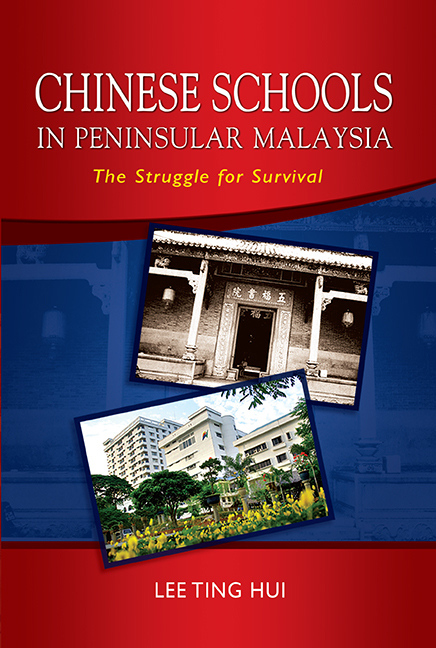Book contents
- Frontmatter
- Contents
- Acknowledgements
- Abbreviations
- Notes on Coverage and Names
- Introduction
- 1 The Years before the Pacific War
- 2 From the Japanese Occupation to Self-Government
- 3 Towards the “Ultimate Objective” of One-medium Education
- 4 One-medium Education under Rukun Negara and the New Economic Policy
- 5 The 1980s: A Decade of Continuing Challenges for the Chinese Schools
- 6 Vision 2020 and the Chinese Schools
- 7 Conclusion: Challenges and Responses
- Glossary
- Bibliography
- Index
- About the Author
1 - The Years before the Pacific War
Published online by Cambridge University Press: 21 October 2015
- Frontmatter
- Contents
- Acknowledgements
- Abbreviations
- Notes on Coverage and Names
- Introduction
- 1 The Years before the Pacific War
- 2 From the Japanese Occupation to Self-Government
- 3 Towards the “Ultimate Objective” of One-medium Education
- 4 One-medium Education under Rukun Negara and the New Economic Policy
- 5 The 1980s: A Decade of Continuing Challenges for the Chinese Schools
- 6 Vision 2020 and the Chinese Schools
- 7 Conclusion: Challenges and Responses
- Glossary
- Bibliography
- Index
- About the Author
Summary
To understand why there were and still are Chinese schools in the Malay Peninsula, we need to know how the land became a British dependency between the eighteenth and twentieth centuries for there were few Chinese living there before the British arrived and even fewer Chinese schools worth noting. The Chinese followed in the wake of the British, arriving to seek a better living which the British could provide. The British initiated vast economic developments which necessitated extensive utilization of manpower. In addition to the attractiveness of the land under British rule, China, from where the Chinese came, was ravaged by wars with foreign powers as well as civil conflicts from about the middle of the nineteenth century, which made life very difficult for ordinary people.
The first Chinese to come to the Malay Peninsula actually arrived in the fifteenth century during the days of the Malacca sultanate, but they were insignificant in numbers compared with those arriving later. Francis Light and Stamford Raffles set up trading stations in Penang and Singapore in 1786 and 1819 respectively, and these stations became great magnets for Chinese traders as well as labourers. In 1826, the British also acquired Malacca from the Dutch and used it for trading. This former sultanate had fallen to Portuguese rule in the fifteenth century and then to the Dutch. Penang, Singapore, and Malacca were then formed into one administrative unit named the Straits Settlements. Then, beginning from 1874, the British moved northwards from Singapore into the hinterland, to the states of Perak, Selangor, Negeri Sembilan and Pahang which they formed into a federation called the Federated Malay States in 1896. The metal, tin, was found to be abundant in Perak and Selangor, and this was what drew the British northwards. In 1909, the British and the Thais reached an agreement to divide between themselves some Malay states straddling the present border between the peninsula and Thailand, and so the British also took over Kedah, Perlis, Kelantan and Trengganu.
- Type
- Chapter
- Information
- Chinese Schools in Peninsular MalaysiaThe Struggle for Survival, pp. 1 - 42Publisher: ISEAS–Yusof Ishak InstitutePrint publication year: 2011

